EAST KENT
Broadstairs
Seaside town N.E. Kent on the A255
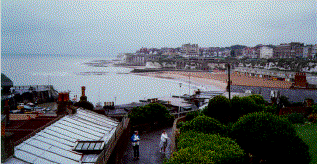 Broadstairs, on the far north east tip of Kent adjoining Margate, was Charles Dickens's favourite holiday resort. He stayed here with his family for a minimum of one month every summer, from 1839 when he was becoming established as a successful writer, through until 1851. On the two years that he went abroad, he was still nostalgic for Broadstairs. Of Italy, in 1844 he said it had, "never so fine a sunset" and in Switzerland in 1846 he missed Broadstairs's "good, old, tarry, salt, little pier".
Broadstairs, on the far north east tip of Kent adjoining Margate, was Charles Dickens's favourite holiday resort. He stayed here with his family for a minimum of one month every summer, from 1839 when he was becoming established as a successful writer, through until 1851. On the two years that he went abroad, he was still nostalgic for Broadstairs. Of Italy, in 1844 he said it had, "never so fine a sunset" and in Switzerland in 1846 he missed Broadstairs's "good, old, tarry, salt, little pier".
In 1839 the Dickens family stayed at No. 40 Albion Street whilst Dickens was finishing Nicholas Nickleby. This must have gone well for it prompted him to write, "We enjoy this place amazingly". It is now No.12, part of the Albion Hotel and is a good starting point for your exploration of Dickensian Broadstairs.
Albion Hotel
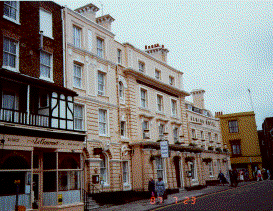 The Albion Hotel fronts onto Albion Street and has gardens at the rear extending down to the promenade, with, "the most beautiful view of the sea from its bay-windows that you can imagine". A plaque on the front of the hotel points out that Dickens stayed there, or the buildings that now comprise it, for some time during the summers of 1839, 1840, 1845, 1849 and 1859.
The Albion Hotel fronts onto Albion Street and has gardens at the rear extending down to the promenade, with, "the most beautiful view of the sea from its bay-windows that you can imagine". A plaque on the front of the hotel points out that Dickens stayed there, or the buildings that now comprise it, for some time during the summers of 1839, 1840, 1845, 1849 and 1859.
On that very first stay in Broadstairs, Dickens visited the Albion (otherwise known as Ballards) with his friend and biographer John Forster, and recorded that he enjoyed a memorable "merry night". He had the highest regard for the landlord, and it would appear that the feeling was mutual, for he wrote, "Mr. Ballard of the Albion Hotel--one of the best and most respectable tradesmen in England. He has a kind of reverence for me".
Dickens House
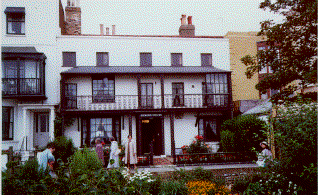 A pedestrian passage by the side of the hotel will lead you down to Victoria Parade. Immediately on your right is Dickens House. Originally a small Tudor building much extended in Victorian times and with the addition of a pretty facade, that includes a decorative wrought iron balcony on the second floor.
A pedestrian passage by the side of the hotel will lead you down to Victoria Parade. Immediately on your right is Dickens House. Originally a small Tudor building much extended in Victorian times and with the addition of a pretty facade, that includes a decorative wrought iron balcony on the second floor.
This house has a double attraction to the Dickens devotee, for in addition to housing an excellent museum to the author its original owner was Miss Mary Pearson Strong, model for the character Betsey Trotwood aunt of David Copperfield, who so valiantly and so hilariously fought a losing battle against the donkeys. In the novel, for reasons of propriety no doubt, Dickens places this house in Dover.
37 Albion Street
Return back up the passage way and pass the front of the hotel, a few doors further down Albion Street is No. 37 (although since the street numbers have been changed, it is not easy to locate precisely). Dickens spent at least three holidays, during the early 1840's in this house, and records the events in many of his letters.
For example in 1840, before sitting down to work on The Old Curiosity Shop the, "writing table is set forth with a neatness peculiar to your estimable friend" and there is "a good array of bottles on display in the dining parlour closet". In 1842, while writing American Notes he looked out of the window to observe his young son Charley, "digging up the sand on the shore with a very small spade, and compressing it into a perfectly impossible wheelbarrow" or as in 1843, laughing away to himself from 9 am as he writes passages of Martin Chuzzlewit, and "At one, he disappears, and presently emerges from a bathing machine and may be seen--a kind of salmon-coloured porpoise--splashing about in the ocean".
Lawn House
Continue along Albion Street, turn right into Harbour Street and walk down towards the arched gateway. On your left, at the entrance to Fort Road is Archway House. When Dickens stayed here it was called Lawn House, and separated from the sea by a cornfield.
In 1840 he worked here for five weeks on The Old Curiosity Shop. Although he was trying to get a lease on Fort House, he was far from disappointed with this one, declaring it, "a most brilliant success--far more comfortable than we have had".
Dickens returned the following year, and managed in his own inimitable way to mix hard work with a great deal of pleasure: "I am hideously lazy--always bathing, lying in the sun, or walking about. I write a No." (edition of Barnaby Rudge) "when the time comes, and dream about it beforehand on cliffs and sands--but as to getting in advance!"
The Tartar Frigate
Never far away from a Dickens house, is a Dickens pub, and Broadstairs is no exception. A little further down Harbour Street, as it bends round to the left is the Tartar Frigate which he described as, "the cosiest little sailor's inn . . . that is to be met around the coast . . . the very walls have long ago learned 'Tom Bowling' and 'The Bay of Biscay' by heart and would be thankful for a fresh song".
Dickens liked nothing better than to sit in the bar of the Tartar Frigate and listen to the tales of the Broadstairs fishermen, whom he immortalised in "Our English Watering Place". Could it be coincidence that the name of that handsome sailor who wins Rosa Bud's heart in The Mystery of Edwin Drood is Mr. Tartar?
Bleak House
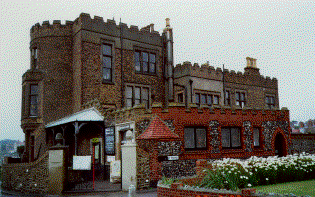 On your walk through the town, you will already have caught glimpses of the sentinel like, castellated house high on the edge of the cliff, with its commanding views of Vikings Bay. In Dickens's time this was known as Fort House, and access is gained by making your way up Fort Road. It is now named after the novel Bleak House whose title it inspired (although that house is in Hertfordshire) and was Dickens's favourite holiday retreat from the mid 1840's until 1852.
On your walk through the town, you will already have caught glimpses of the sentinel like, castellated house high on the edge of the cliff, with its commanding views of Vikings Bay. In Dickens's time this was known as Fort House, and access is gained by making your way up Fort Road. It is now named after the novel Bleak House whose title it inspired (although that house is in Hertfordshire) and was Dickens's favourite holiday retreat from the mid 1840's until 1852.
Bleak House is now open to the public as a memorial to the author, and many of the rooms are preserved as Dickens would have known them. The billiards room and dining room, both on the ground floor have a variety of mementos and the upstairs bedroom with its spectacular views, houses the original big brass bed from the Bull Hotel Rochester.
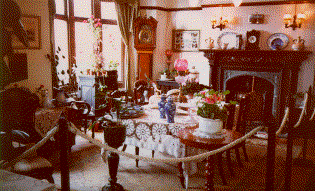 Next to the bedroom is the small study looking straight out across the sea in which Dickens planned Bleak House and in which he wrote, sometimes for eight hours at a stretch, the greater part of his personal favourite and most famous novel David Copperfield. It was in this small study, in 1851 that Dickens began the article "Our English Watering Place" with the words: "Half awake and half asleep, this idle morning, in our sunny windows on the edge of a chalk cliff in the old fashioned watering place to which we are a faithful resorter, we feel a lazy inclination to sketch its picture."
Next to the bedroom is the small study looking straight out across the sea in which Dickens planned Bleak House and in which he wrote, sometimes for eight hours at a stretch, the greater part of his personal favourite and most famous novel David Copperfield. It was in this small study, in 1851 that Dickens began the article "Our English Watering Place" with the words: "Half awake and half asleep, this idle morning, in our sunny windows on the edge of a chalk cliff in the old fashioned watering place to which we are a faithful resorter, we feel a lazy inclination to sketch its picture."
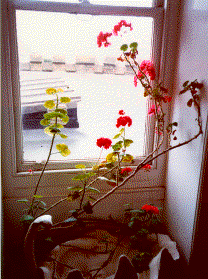 "The place seems to respond. Sky, sea, beach and village, lie as still before us as if they were sitting for the picture. It is dead low water. A ripple plays among the ripening corn upon the cliff, as if it were faintly trying from recollection to imitate the sea. . . ."
"The place seems to respond. Sky, sea, beach and village, lie as still before us as if they were sitting for the picture. It is dead low water. A ripple plays among the ripening corn upon the cliff, as if it were faintly trying from recollection to imitate the sea. . . ."
Geranium in Bleak House, Dickens's favourite flower
Canterbury
On the A2 London to Dover Road
This ancient city, famous throughout the world, known and loved by Dickens features largely in David Copperfield , ". . . the sunny street of Canterbury, dozing as it were in the hot light . . . the sight if its old houses and gateways, and the stately, grey Cathedral, with the rooks sailing round the towers". Unfortunately a number of its old buildings including some associated with Dickens were lost in the blitz. Of those that remain, it is only possible to suggest likely candidates to match with his descriptions, but as with Broadstairs and Rochester, they are all within easy walking distance.
Dr. Strong's School
Adjacent to the Cathedral is The King's School. Although Dickens denied this to be the model for Dr. Strong's, where David Copperfield was so happy, the actual school must have been close by, for it was, "a grave building in a courtyard, with a learned air about it that seemed well suited to stray rooks and jackdaws who came down from the Cathedral towers to walk with a clerky bearing on the grass-plot".
The Sun Hotel
At the other end of the precinct, through and immediately to the left of the Christ Church Gate, is the Cathedral Gate Hotel. Formerly the Sun Hotel, this building now serves as the Cathedral Restaurant and is generally considered more likely to be the "little inn" where Mr. Micawber "put up" on his first visit to Canterbury, than the shop, further to your right in Sun Street, that claims that honour.
It was at the Sun that Mr. and Mrs. Micawber--notwithstanding their chronic impecuniosity--thus entertained David Copperfield: "We had a beautiful little dinner. Quite an elegant dish of fish; the kidney end of a loin of veal roasted; fried sausage-meat; a partridge and a pudding. . . ."
The House of Agnes
Make your way to the High Street, turn right and follow this right through to St. Peter's Street and eventually out through Westgate. A little further up on the left of St. Dunstan's Street is the House of Agnes Hotel. This, or somewhere very similar is where David Copperfield found a haven with Mr. Wickfield, his daughter Agnes and encountered the scheming Uriah Heap.
"At length we stopped before a very old house bulging out over the road; a house with long low lattice-windows bulging out still farther, and beams with carved heads on the ends bulging out too, so that I fancied the whole house was leaning forward, trying to see who was passing on the narrow pavement below".
Deal
Small fishing town north of Dover on the A258
Deal was familiar to Dickens from his walks between Broadstairs and Dover. In Bleak House, his narrator Esther Summerson, travels from London down to Deal to see Richard Carston who is stationed at the Royal Marine barracks: "We came into the narrow streets of Deal, and very gloomy they were, upon a raw misty morning. The long flat beach with its little irregular houses, wooden and brick, and its litter of capstans, and great boats and sheds, and bare upright poles with tackle and blocks, and loose gravely waste places overgrown with weeds. . . ."
Things, however began to seem brighter, ". . . when we got into a warm room in an excellent hotel (The Royal) . . . Deal began to look more cheerful. Our little room was like a ship's cabin".
The Royal Hotel was formerly The Three Kings where Sir William Hamilton, his wife Emma and Nelson's sister stayed in 1801 when Nelson's fleet lay off Deal.
It may also be the Admiral Benbow of Dickens's "Out of Season" essay from the collection (Reprinted Pieces).
Dover
Busy sea port at the extent of the A2
Dickens often visited Dover when travelling to and from the Continent. In The Uncommercial Traveller, he detests it "for the self-complacency with which it goes to bed. . . ." whilst he has to board the packet for Calais. It features in Little Dorrit and in A Tale of Two Cities he describes the Dover of 1775 as a, 'little, narrow, crooked town" with air "of so strong a piscatory flavour that one might have supposed sick fish went up to be dipped in it. . . ." In this story the Dover inn, where Jarvis Lorry meets by appointment the French born Lucie Manette, is based almost certainly on The Ship, where Dickens stayed in 1856. The next time Dickens visited the Ship, it had been rebuilt as the Lord Warden Hotel. It is now the Dover Headquarters of Sealink and one of the few buildings in this part of the town to have survived the bombing of the Second World War. To locate the Lord Warden, travel south out of the town centre up Snargate Street and across the Viaduct.
Earlier in 1852, Dickens and his friend Wilkie Collins lodged at number 10 Camden Crescent. This building was a victim of the war and only numbers 1 to 4 remain. Number 10 is now the sight of the incongruously designed Dover Mail Hotel, situated just a little back from the promenade, in the central harbour area.
Folkestone
7 miles south west of Dover on the A20
Dickens came to Folkestone many times, taking advantage of the cross channel packet service to Boulogne. In 1853, he stayed for a few days holiday at the "Pavilion Hotel". He was engaged at the time in writing A Child's History of England, and the town appears as Pavilionstone in his essay "Out of Town" from the collection (Reprinted Pieces).
Returning in the summer of 1855 he rented number 3 Albion Villas, "a pleasant little house with the sea below and the scent of thyme sweetening the breezes from the downs".
Although working furiously on the beginning of his novel Little Dorrit he found time for, "swarming up the face of a gigantic and precipitous cliff" and could be seen many a day "from the British Channel, suspended in mid-air with his trousers very much torn at fifty minutes past 3pm".
Margate
Northern tip of the Isle of Thanet on the A28
During his years of vacations at Broadstairs, Dickens would enjoy exploring the Isle of Thanet. The towns and villages were familiar to him and they are mentioned in several of his stories, as in Bleak House: "It is the hottest long vacation known for many years. All the young clerks are madly in love, and according to their various degrees, pant for bliss with the beloved object at Margate, Ramsgate or Gravesend".
He particularly liked visiting Margate Theatre and recorded in 1844, seeing a wildly burlesqued version of the tragedy Athenian Captive and in 1847 a most excellent performance of As You Like It.
The Theatre Royal is on the corner of Addington Road, found by following union Crescent out of the main town centre (Cecil) Square.
Ramsgate
South of Broadstairs on the A254
During the years that he spent holidays at Broadstairs, Dickens often made the six hour journey from London by Paddle Steamer to Ramsgate, staying overnight on occasion at the Royal Oak Hotel.
It was from this hotel in 1847 that Dickens's friend Hans Christian Anderson left to return to Denmark after his first English tour. He recorded that Dickens "had walked from Broadstairs to say goodbye to me; and was in a green scotch dress and gaily coloured shirt, extremely smart English. He was the last person to shake my hand in England. . . ."
In "Tugges at Ramsgate" (Sketches by Boz), the Tugges
family enjoy their revelling in nearby Pegwell Bay.
THE WEALD OF KENT
Dickens did not stay for any length of time in the Central-South West of the county, but he made numerous trips to the area, including one recorded visit to Sevenoaks, when he rented an apartment in Seale House. A few years after Dickens's death, his daughter Katey and her artist husband Carlo Perugini came to live in Sevenoaks, first staying at the White Hart Inn, on the Tonbridge Road and then renting Park Cottage two hundred yards further up the hill.
Many of the places appear in his stories, but often as a combination of characteristics and names. For example Muggleton, scene of the cricket match in Pickwick Papers between the All-Muggleton eleven and the team from Dingley Dell, has features in common with both West Malling and Maidstone, the County Town.
Sandling, near Maidstone is favoured as the original for Dingley Dell, with Cob Tree Hall representing Manor Farm, home of Mr. Wardle and family where the Pickwickians spend Christmas and later attend the wedding festivities of Bella Wardle.
In No Thoroughfare (Christmas Stories) Walter Wilding visits Groombridge Wells on the Sussex border, in his quest for his true identity. This is an amalgam of the village of Groombridge and the nearby town of Tunbridge Wells, where Dickens had a son at school. The author must have been in romantic mood when he visited this spa because he made it the setting for one of Mr. Finching's many proposals to Flora in Little Dorrit and the scene of Miss Twinkleton's early romance with, "foolish Mr. Porters" in The Mystery of Edwin Drood.
In Dombey and Son, the villain James Carker, returned from France, is escaping from Mr. Dombey's wrath. He lurks by an English country railway station, identified as Paddock Wood, and muses about death under the wheels of a train.
On Friday, June 9th, 1865 repairs were being made to the railway line on the bridge spanning the Medway tributary between Staplehurst and Headcorn. Charles Dickens, was returning to London from France on the Brussels express via Folkestone.
There was a misunderstanding of dates and times by the railway gangers which resulted in an horrendous crash, from which Dickens never fully recovered. In 1868 he wrote, "My escape in the Staplehurst accident of three years ago is not to be obliterated from my nervous system. To this hour I have sudden vague rushes of terror, even when riding in a hansom cab, which are perfectly unreasonable but quite insurmountable".
Dickens died at Cadshill on June 9th, 1870 aged 58. Five years to the day since the Staplehurst disaster.

 Top of Page
Top of Page
 Matsuoka's Home Page
Matsuoka's Home Page 

 Broadstairs, on the far north east tip of Kent adjoining Margate, was Charles Dickens's favourite holiday resort. He stayed here with his family for a minimum of one month every summer, from 1839 when he was becoming established as a successful writer, through until 1851. On the two years that he went abroad, he was still nostalgic for Broadstairs. Of Italy, in 1844 he said it had, "never so fine a sunset" and in Switzerland in 1846 he missed Broadstairs's "good, old, tarry, salt, little pier".
Broadstairs, on the far north east tip of Kent adjoining Margate, was Charles Dickens's favourite holiday resort. He stayed here with his family for a minimum of one month every summer, from 1839 when he was becoming established as a successful writer, through until 1851. On the two years that he went abroad, he was still nostalgic for Broadstairs. Of Italy, in 1844 he said it had, "never so fine a sunset" and in Switzerland in 1846 he missed Broadstairs's "good, old, tarry, salt, little pier".
 The Albion Hotel fronts onto Albion Street and has gardens at the rear extending down to the promenade, with, "the most beautiful view of the sea from its bay-windows that you can imagine". A plaque on the front of the hotel points out that Dickens stayed there, or the buildings that now comprise it, for some time during the summers of 1839, 1840, 1845, 1849 and 1859.
The Albion Hotel fronts onto Albion Street and has gardens at the rear extending down to the promenade, with, "the most beautiful view of the sea from its bay-windows that you can imagine". A plaque on the front of the hotel points out that Dickens stayed there, or the buildings that now comprise it, for some time during the summers of 1839, 1840, 1845, 1849 and 1859.
 A pedestrian passage by the side of the hotel will lead you down to Victoria Parade. Immediately on your right is Dickens House. Originally a small Tudor building much extended in Victorian times and with the addition of a pretty facade, that includes a decorative wrought iron balcony on the second floor.
A pedestrian passage by the side of the hotel will lead you down to Victoria Parade. Immediately on your right is Dickens House. Originally a small Tudor building much extended in Victorian times and with the addition of a pretty facade, that includes a decorative wrought iron balcony on the second floor.
 On your walk through the town, you will already have caught glimpses of the sentinel like, castellated house high on the edge of the cliff, with its commanding views of Vikings Bay. In Dickens's time this was known as Fort House, and access is gained by making your way up Fort Road. It is now named after the novel Bleak House whose title it inspired (although that house is in Hertfordshire) and was Dickens's favourite holiday retreat from the mid 1840's until 1852.
On your walk through the town, you will already have caught glimpses of the sentinel like, castellated house high on the edge of the cliff, with its commanding views of Vikings Bay. In Dickens's time this was known as Fort House, and access is gained by making your way up Fort Road. It is now named after the novel Bleak House whose title it inspired (although that house is in Hertfordshire) and was Dickens's favourite holiday retreat from the mid 1840's until 1852.
 Next to the bedroom is the small study looking straight out across the sea in which Dickens planned Bleak House and in which he wrote, sometimes for eight hours at a stretch, the greater part of his personal favourite and most famous novel David Copperfield. It was in this small study, in 1851 that Dickens began the article "Our English Watering Place" with the words: "Half awake and half asleep, this idle morning, in our sunny windows on the edge of a chalk cliff in the old fashioned watering place to which we are a faithful resorter, we feel a lazy inclination to sketch its picture."
Next to the bedroom is the small study looking straight out across the sea in which Dickens planned Bleak House and in which he wrote, sometimes for eight hours at a stretch, the greater part of his personal favourite and most famous novel David Copperfield. It was in this small study, in 1851 that Dickens began the article "Our English Watering Place" with the words: "Half awake and half asleep, this idle morning, in our sunny windows on the edge of a chalk cliff in the old fashioned watering place to which we are a faithful resorter, we feel a lazy inclination to sketch its picture."
 "The place seems to respond. Sky, sea, beach and village, lie as still before us as if they were sitting for the picture. It is dead low water. A ripple plays among the ripening corn upon the cliff, as if it were faintly trying from recollection to imitate the sea. . . ."
"The place seems to respond. Sky, sea, beach and village, lie as still before us as if they were sitting for the picture. It is dead low water. A ripple plays among the ripening corn upon the cliff, as if it were faintly trying from recollection to imitate the sea. . . ."

 Top of Page
Top of Page
 Matsuoka's Home Page
Matsuoka's Home Page 